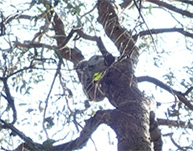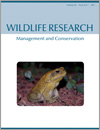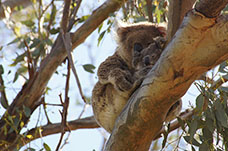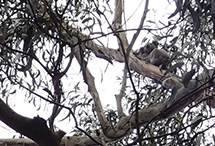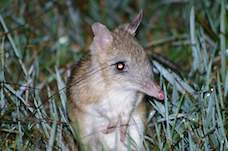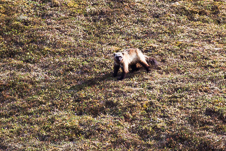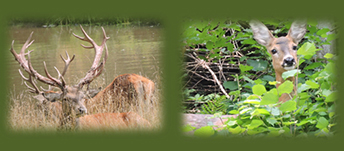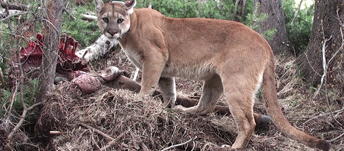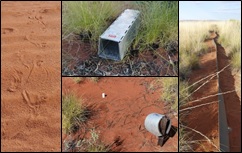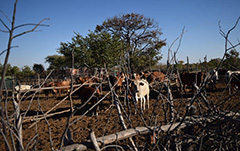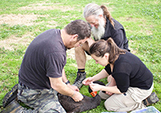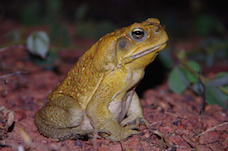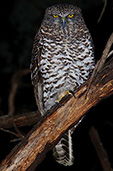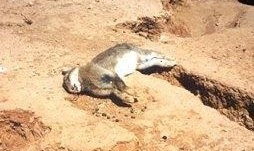Wildlife Research
Volume 44
Numbers 6 & 7 2017
Koalas are virtually invisible in forests because they are solitary animals in large home ranges containing thousands of trees. Radiotracking studies at Eden showed that lack of sightings should not necessarily cause concern. However, sightings are rapidly increasing in an area of declining forest where further tracking would improve our understanding of historic irruptions and declines throughout the koala’s range.
In many areas of Australia, koalas are under threat from a loss of habitat and disease. Climate change will exacerbate these processes, as well as affect the quality of remaining habitat. Modelling the effects of climate change on koalas will help guide conservation strategies for long-term survival of the species.
Explorers didn’t see koalas when forests were managed by Aborigines using firesticks. Disruption of burning created thick forests of sick trees with nutritious and palatable foliage, feeding irruptions of koalas, followed by declines as trees were cleared by settlers or died during the Federation Drought. Sustainable populations should be reinstated using traditional knowledge underpinned by modern ecological and forestry science.
Conservation of threatened species will increasingly rely on innovative strategies and research. This trial assisted colonisation of the eastern barred bandicoot showed this technique could allow the establishment of a self-sustaining population of this endangered species. Pursuing novel management and research avenues is necessary to safeguard vulnerable species and ecosystems.
Understanding the vulnerability and variability of different sex and age cohorts to harvest may have implications to harvest sustainability of wolverine. We examined the temporal variability of wolverine sex and age composition, and evaluated the impact of the harvest season length on breeding wolverines. Late winter harvest likely has a more significant impact on wolverine populations than early winter harvest, because of increased harvest of adults and breeding females.
Land-use change may represent a major driver for wildlife population trends in most ecosystems. In Central Eastern Alps (Italy), the increase in canopy cover and a general landscape simplification during 1973–2011 period facilitated red deer range expansion and density increase. Land use change and red deer growth rate impacted on roe deer population dynamics. These results may help managers to apply an effective adaptive-management planning technique for target locations to keep the ecosystem balanced.
Robust and efficient survey methods are essential for the conservation of cryptic and threatened species. This study aimed to review the current recommended survey guidelines for the swamp skink (Lissolepis coventryi). Our findings emphasise the importance of such a review and suggest alternative detection methods for future monitoring.
We tested mythology that presents pumas as competitors for antlered elk and deer prized by the hunting community, in the Rocky Mountains, USA. We found that pumas killed few antlered ungulates, avoided antlered elk, and only slightly selected for antlered deer. Our results highlight that killing large carnivores over competition for antlered ungulates is unfounded.
The ability of ecologists to measure species diversity and abundance levels is greatly dependent on selecting the most optimal survey technique. We compared the efficacy of three popular monitoring techniques used in the spinifex sand-plain habitat in Central Australia. Our results provide a clear analysis of the benefits and cost of each technique and offers recommendations for ecologist conducting surveys within arid environment.Introduction
Lethal control of predators related to livestock depredation is a major driver of declines in large predator populations globally. We investigated the perceptions and actions of a livestock farming community in Botswana, and found that lethal control was commonly used, especially in households previously denied compensation for losses, but that its use was unrelated to past livestock losses to predation and the benefits the household derived directly from wildlife. We suggest that efforts must be made to connect the financial costs incurred by farming alongside wildlife with the financial benefits derived from their presence and that greater efforts must be made to ensure timely compensation payments.
Information regarding the movement patterns of wildlife is crucial for development of appropriate management actions. We conducted a field test of SPOT Trace GPS receivers on feral black swans near Auckland Airport and found that the units provided a highly effective means of describing the birds’ locations in relation to the potential for aircraft strike. Such knowledge can help mitigate human-wildlife conflicts.
Since their introduction into Australia, cane toads have spread to over 1 million square kilometres, causing significant disturbance to native ecosystems. The Australian invasion has also had a toll on the cane toads themselves, and we show that cane toads introduced into Australia have very little immune gene diversity. This chink in the cane toad armour could represent low immune health within the population and could be exploited for control management.
Owls have great potential as surrogates to monitor how systems change through time however our understanding of survey approaches is limited. This research assesses our capacity to detect three Australian owl species and demonstrates that species, season and temperature impact on survey success. We suggest that owls can be used to assess change in systems through time but survey approaches need to be tailored and adapted for each individual target species.
Subadult rabbits in a population that had been heavily suppressed by rabbit haemorrhagic disease used an average of four warrens each in an overlapping, irregular array. This type of movement among warrens could play a critical role in disease transmission. It may be particularly important during periods of low population density when other density-dependent modes of transmission are suppressed.
